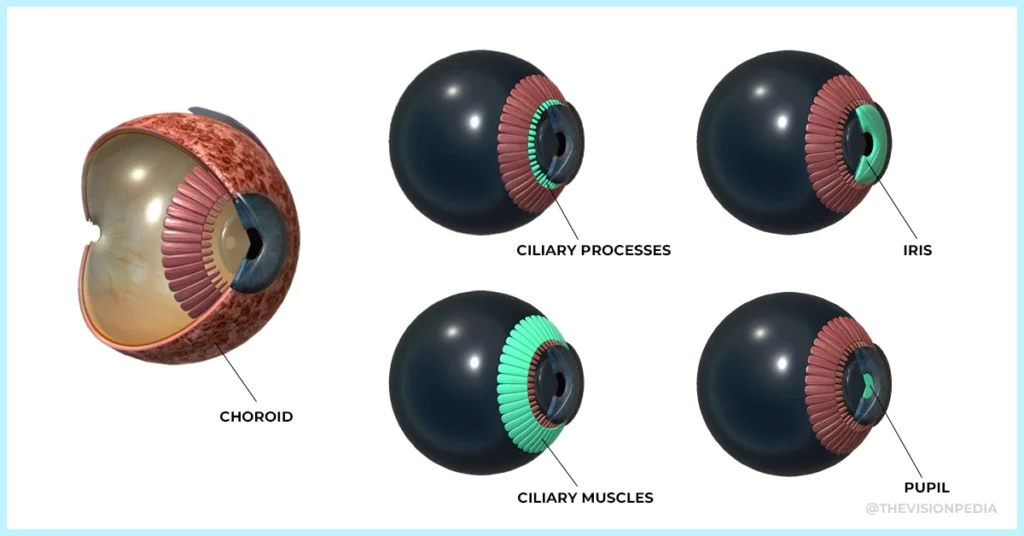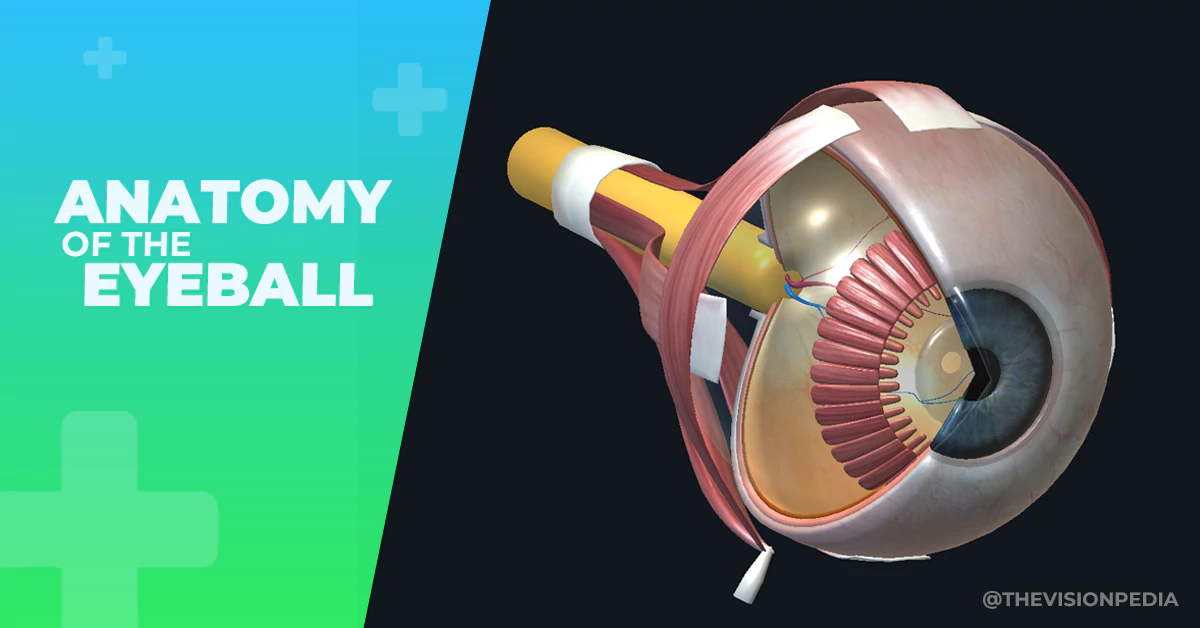|
Getting your Trinity Audio player ready...
|
Introduction:
Each eyeball is composed of a cystic structure that is kept in check by the pressure within it. The eyeball, although commonly called a globe, is an ablate spheroid.
The anterior and posterior poles are the central points of the maximum convexities of both anterior and posterior curvatures. The mid-plane of the two poles is where the equator of an eyeball lies.
The eyeball is a bilateral and spherical organ that houses the structures responsible for vision. It lies in a bony cavity within the facial skeleton known as the bony orbit.
Dimensions of an adult eye
| Anteroposterior diameter | 24 mm |
| Horizontal diameter | 23.5 mm |
| Vertical diameter | 23 mm |
| Circumference | 75 mm |
| Volume | 6.5 ml |
| Weight | 7 gm |
Anatomically the eyeball can be divided into three parts.
- Fibrous layer ( outermost layer )
- Vascular layer ( middle layer )
- Nervous layer ( inner layer )
These layers have different structures and functions.

1) Fibrous layer ( outermost layer )
It protects intraocular contents by creating a strong, dense wall and, Its primary function is to provide the shape of the eye and support the deeper structures.
The cornea is the transparent portion of the anterior 1/6th fibrous coat, and the sclera is the 5/6th portion of the posterior opaque layer.
The cornea is placed into the sclera in the same way as a watch glass.
The junction of the cornea and the sclera is called the limbus. The limbus is where the conjunctiva attaches to itself.
The fibrous layer is the eye’s outermost layer, consisting of two continuous parts.
- Sclera
- Cornea

Sclera
The sclera is developed from the fibrous layer of mesenchyme surrounding the optic cup (corresponding to the dura of CNS)
The sclera comprises most of the fibrous layer, approximately 85%, and provides attachments to the extraocular muscles.
The extraocular muscles are responsible for the eye’s movement, and several vessels and nerves penetrate through the sclera, including the optic nerve posteriorly.
Cornea
The epithelium is formed from the surface ectoderm.
Other corneal layers, viz. endothelium, Descemet’s membrane, stroma, and Bowman’s layer, are derived from the fibrous layer of mesenchyme lying anterior to the optic cup.
The sclera and the cornea are directly continuous with each other.
Light entering the eye is refracted by the cornea.
The sclera is visible as a white portion of the eye and cornea continuous anteriorly with the sclera and transparent and positioned centrally at the front of the eye.
2) Vascular layer ( middle layer )
It supplies nutrition to the various structures of the eyeball and lies underneath the fibrous layer. It consists of three continuous parts.
- Choroid
- Ciliary body
- Iris

Choroid:
It is the layer of connective tissue and blood vessels and it provides nourishment to the outer layer of the retina.
It is derived from the inner vascular layer of mesenchyme that surrounds the optic cup.
Ciliary body:
The ciliary body is comprised of two parts.
- Ciliary muscles
- Ciliary processes
a) Ciliary muscles: The ciliary muscles consist of a collection of smooth muscles arranged in three orientations.
- Longitudinal
- Circular
- Radial
When these muscles contract, the diameter of the circular ciliary body reduces in size
When this happens, the zonular fibers relax, reducing the tension applied to the outside of the lens, allowing the lens to return to a more rounded shape.
This process is known as accommodation and adjusts the lens for near vision.
Conversely, when the ciliary body is relaxed, the diameter of the ciliary body is greater, which means the zonular fibers are held tight, pulling the lens flat. This optimizes the lens for long-distance vision.
The ciliary body, therefore, controls the shape of the lens.
In addition to adjusting the lens shape, the ciliary body also contributes to forming the aqueous humor.
b) Ciliary Processes: These attach the lens through the ciliary body via zonular fibers.
The Zonular fibers form the suspensory ligament of the lens.
The final structure of the vascular layer is the iris.
Iris:
This is a circular structure with an aperture in the center called the pupil. The iris is the component of the eye that gives you your eye color.
It has two arrangements of fibers that control the size of the pupil.
- Circular fibers
- Radial fibers
a) Circular fibers: The circular fiber makes up the ‘sphincter pupillae’, which is innervated by the parasympathetic nervous system.
Activation of the system causes the constriction of the pupil, which thereby limits the amount of light that can enter the eye.
b) Radial Fibers: These make up the ‘dilater pupillae’ eye muscle innervated by the sympathetic nervous system and cause pupil dilation, thereby increasing the amount of light that can enter the eye.
3) Inner layer:

The inner layer consists of the retina, the light-detecting part of the eye, and is concerned with visual functions.
The retina itself is comprised of two cellular layers:
- Neural layer
- Pigmented layer
Neural layer:
It consists of the photoreceptors, i.e.: the light-detecting cells of the retina, and is located posteriorly and laterally in the eye.
Pigmented layer:
The pigmented layer lies Underneath the neural layer and is attached to the choroidal layer, which supports the neural layer and continues around the whole inner surface of the eye.
Anteriorly, the pigmented layer continues, but the neural layer does not. This part is known as the non-visual retina.
Posteriorly and laterally, both layers of the retina are present.
The optic part of the retina can be viewed during ophthalmoscopy or funduscopy.
The center of the retina is marked by the area known as the macula lutea.
It is yellowish and highly pigmented.
The macula contains a depression called the fovea entrails, with a high concentration of cones. These light receptor cells function best in bright light conditions and are responsible for high-acuity color vision.
The area where the optic nerve enters the retina is known as the optic disc.
It contains no light-detecting cells and is therefore referred to as the blind spot of the retina.
The central retinal artery and its branches are visible during funduscopy.
Segments and chambers of the eyeball:
Anterior Segment
There are two fluid-filled areas in the eye known as the
- Anterior chamber
- Posterior chamber

Anterior Chamber
The anterior chamber is located between the cornea and the iris.
The anterior chamber is about 2.5 mm deep in the center in normal adults.
It is shallower in hypermetropes and deeper in myopes but is almost equal in the two eyes of the same individual. It contains about 0.25 ml of aqueous humor.
Posterior Chamber
It is a triangular space containing 0.06 ml of aqueous humor.
The posterior chamber is a small chamber located behind the iris and anterior to the lens and suspensory ligaments.
The two chambers are continuous with one another via the pupillary opening.
The chamber is filled with aqueous humor, a clear plasma-like fluid that nourishes and protects the eye.
The aqueous humor is secreted first into the posterior chamber, flows to the anterior chamber via the pupil, and is then absorbed into the canal of schlemm, also known as the scleral venous sinus.
This channel encircles the eye lying at the point between the cornea and the iris.
If the flow of aqueous humor is obstructed, the intra-ocular pressure will rise and will cause the condition known as glaucoma.
Posterior segment.
Vitreous Chamber
The vitreous chamber consists of the vitreous humor, a colorless gel-like fluid that fills the space between the lens and the retina.
It occupies 80% of the volume of the eye consisting of water, collagen, and hyaluronic acid.
A vitreous membrane is a collagen layer separating the vitreous humor from the rest of the eye.
This membrane consists of two known anatomical parts.
- Anterior hyaloid membrane: It separates the font of the vitreous from the lens.
- Posterior hyaloid membrane: It separates the rear of the vitreous from the retina.
The vitreous perform vital roles such as protecting the eye, maintaining the shape, and maintaining the necessary pressure to keep the retina in place
Crystalline lens
The lens of an eye is a transparent, biconvex intraocular structure, which, together with the cornea, transmits light to the retina using minimal light scattering.
The crystalline lens lies between the anterior segment ( anterior chamber and posterior chamber ) and the posterior segment ( vitreous chamber), separating both chambers from each other
The lens is flatter on its anterior than its posterior side.
The ciliary muscles can alter the shape of the lens, changing the focal distance from the retina and bringing the image into sharp focus.
References
https://www.aao.org/eye-health/anatomy/parts-of-eye
A K Khurana. Comprehensive Opthalmology Fourth Edition.






